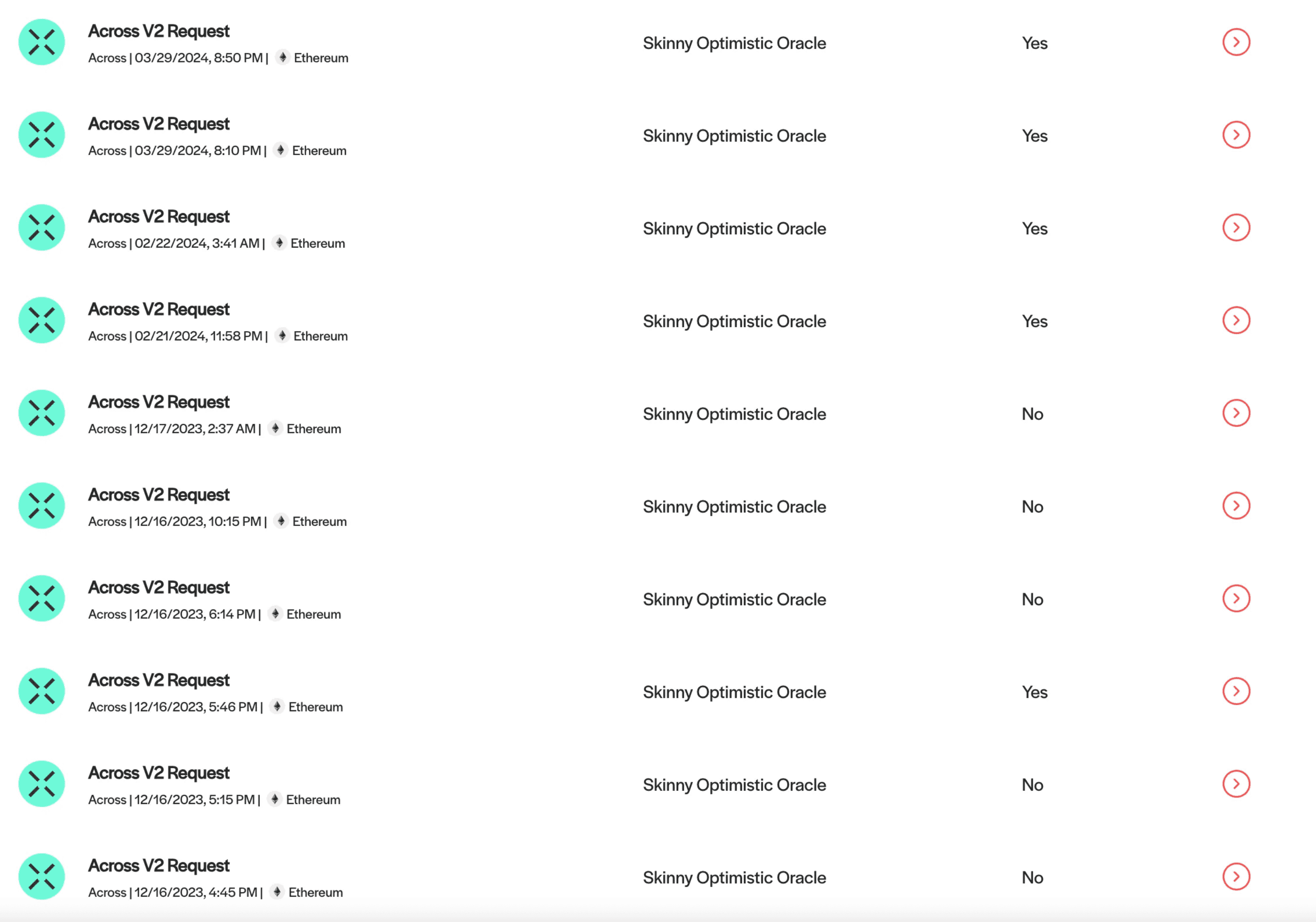Tldr; Across is a modular system that can be unbundled into three individual layers. These layers act as independent modules, making for a decentralized and secure system that benefits users and applications alike.
Across is the cross-chain space’s first intents-based interoperability protocol that offers a modularized tech stack for users and developers.
Across’ modularity offers significant UX and security benefits over other interoperability systems.
In this system, users do not take on risk because relayers are responsible for fulfilling their intents.
At Across’ settlement layer, activity is optimistically verified using a mechanism that relies on one honest disputer assumption.
The cross-chain space has never been more active. In this fast-growing ecosystem, users have an abundance of different interoperability solutions to choose from. Across is one of those solutions and it found success by offering quick and cheap transfers powered by intents.
In early 2024, Across rolled out its V3 upgrade, introducing the cross-chain ecosystem’s first modular, intents-based interop solution. V3 offers new possibilities for users and developers that go beyond the remit of other bridging protocols.
The system’s modular design also prioritizes security. In our last deep dive on Across’ security, we explained how using canonical assets and an intents-based architecture minimizes risks for users. We expand on this topic in this follow-up, exploring how modularity offers security benefits over other designs.
Unpacking Across’ modular system
Across lets users bridge canonical assets because this is the only trustless way to transfer value. It makes transfers happen with intents, where users express their desired action and then third parties step in to fulfill the request. The user receives canonical assets at the destination without taking on any additional risk.
Across is also a modular system. That means it can be unbundled into individual modules. We think of Across’ modules as three distinct layers:
The intent layer, where users articulate their desired action.
The relayer layer, where third parties compete to fulfill users’ intents. These relayers are part of a unified network and they front their capital to serve users.
The settlement layer, where relayers get repaid and orders are settled. Applications can plug into this layer to offer users cross-chain actions.

Across unbundled: the intent layer, the relayer layer, and the settlement layer are independent modules in the system.
Where Across emerged as an elegant solution for quick and cheap Layer 1<>Layer 2 transfers, V3 is a significant level-up that lets applications plug into the system to access capital and fulfill cross-chain intents.
Several components feed into Across’ three layers. At the intent layer, users indicate what they would like to happen. At the relayer layer, relayers answer to these intents and LPs commit their capital to a pool to ensure the relayers can get repaid. At the settlement layer, relayers get rapid repayment with LP capital, with UMA’s Optimistic Oracle (OO) verifying each repayment. Across rebalances liquidity through each chain’s canonical bridge when it makes repayments.
These components are the key to Across’ modularity. They illustrate the system’s focus on decentralization, where individual pieces feed into one stack. The result is an elegant solution that serves the needs of users and developers alike in a secure manner. Users can get their intents filled quickly and cheaply (including cross-chain actions like swaps), while applications can access a network of relayers and settle orders to offer users greater flexibility.
This approach differs from other interoperability systems. As the Across stack is fully decentralized, it does not rely on trusting entities. Our last security deep dive explained how Across’ trustless design offers a better experience to users — they only express their intent at the intent layer and the relayer takes on the risk. In Across’ modular system, independent relayers fulfill intents and the transaction gets settled in a decentralized manner at the settlement layer.
How modularity benefits integrated protocols
Across’ modular-based architecture benefits applications because it lets them access capital and settle intent order flow. These applications also benefit from the system’s advanced security — the system’s stack of modules is secure and decentralized and the applications only need to plug into the modules they want to suit their needs.
At the intent layer, applications can submit intent order flow. At the relayer layer, they can access the relayer network and access the unified cross-chain intents standard proposed by Across and Uniswap Labs. And at the settlement layer, applications can get their intents-based orders settled, regardless of the origin.
Across is a fully-fledged developer tooling protocol where applications can access individual modules. This is a dramatic shift from other bridging solutions. Many bridges lock funds and ask the user to take on risk through representative assets. Messaging systems take an alternative approach with canonical assets but they rarely eliminate trust. Bridged token standards aim to help users and applications but they still ask them to trust a proprietary solution. None of these competing solutions offer the same trustlessness and security through modularity like Across.
Optimistic verification at the settlement layer
In part one of this series, we covered how using canonical assets with intents has security advantages. We’ve also explained the benefits of Across’ modular tech stack from a security perspective.
A core component of Across’ decentralized stack is UMA’s Optimistic Oracle. With the OO, Across optimistically verifies transfers. Transactions are assumed to be valid until someone raises a dispute and only one honest actor needs to flag invalid data within a challenge window. As every actor in the system is incentivized to act honestly, disputes are rare.
Optimistic verification offers a key advantage in the way orders are settled at the settlement layer. While relayers front orders to offer users extremely fast fills, they can be repaid separately with less urgency. Relayers take on this risk and trust UMA to optimistically verify their repayment. When relayers are repaid, the order is settled.
Relayers front orders extremely quickly and get repaid separately with less urgency.
As there is a challenge window for disputes and relayers must wait for their repayments to be validated, the Across system adds a time-latency burden. But the relayers take on the burden because they front their assets. Users do not take on any risk because Across adopts an intents-based architecture: they simply express their intent and relayers fill the order then wait for UMA to verify their repayments.

UMA validates Across transfers and settles dispute cases. As the system incentivizes every participant to act honestly, disputes are rare (Source: UMA oracle)
Across’ optimistic design is comparable to those that secure the Layer 2 Optimistic Rollups Arbitrum and Optimism, which have grown to billions of dollars in value as they focus on building Ethereum’s scalable future.
A decentralized stack to power the interoperable future
In summary, we’ve detailed how Across can be unbundled into three individual layers. The intent layer, relayer layer, and settlement layer are modules that allow users and developers to plug into the system according to their needs.
Across’ modular-based framework is unlike other interoperability solutions. It’s a design that includes many individual components, optimizing for decentralization and security. Users and developers plug into the modules they need, and UMA’s OO keeps the system secure under the hood.
In the previous edition to this series, we explained how Across’ commitment to Canonical Asset Maximalism and intents keeps users safe. The system’s modular design is also crucial here, as it also optimizes for security while unlocking new possibilities. These factors combined make for a powerful decentralized system that advances the cross-chain ecosystem.
Words by @dreamsofdefi

